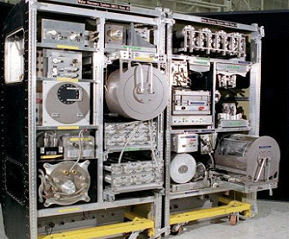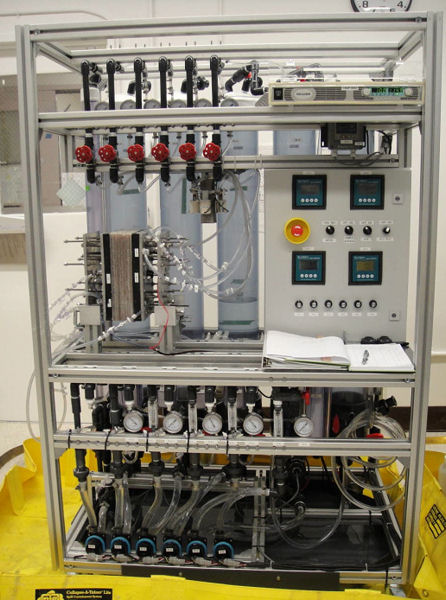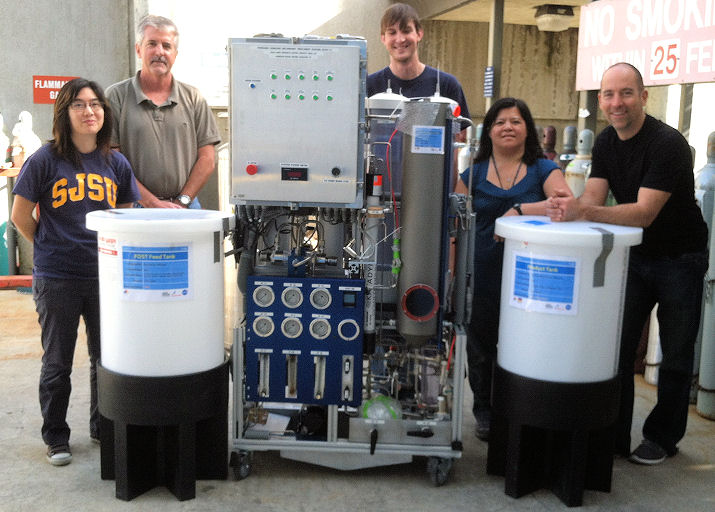
Complete water recycling systems both reduce cost and protect the health astronauts. The International Space Station (ISS), pictured above, has had a water-recycling system since 2009. Photo courtesy of Michael T. Flynn, U.S. National Aeronautics and Space Administration (NASA) Ames Research Center.
On Jan. 30, water industry professionals gathered to attend a Water Environment Federation (WEF; Alexandria, Va.) and Water Environment Research Foundation (WERF; Alexandria) VIP luncheon in Chicago. The luncheon, which marked both the conclusion of the eighth annual WERF Research Forum and the beginning of the 2013 WEF midyear meeting, featured keynote speaker Michael T. Flynn, physical scientist for the U.S. National Aeronautics and Space Administration (NASA) Water Technology Development Laboratory, at Ames Research Center. During Flynn’s discussion, titled, “Water Innovations and Lessons Learned from Water Recycling in Space,” attendees learned about NASA’s water-recycling research.
“One of the most valuable commodities you have [in space] is your waste,” Flynn said. “Our job is to recycle these wastes and turn them into useful metabolic supplies.” This waste includes wastewater, carbon dioxide, volatile organic solid waste, and heat.
The concept of providing resources for space missions has evolved. In the past, astronauts took all of their supplies, including air and water, with them to space for missions that lasted hours to days. Now, missions can last much longer, with the 10- to 20- year life span of the International Space Station (ISS) and the 2 years it takes for a mission to Mars. For these long-term missions, complete water recycling is justified to reduce mission costs, Flynn said.
Water is one of the most important resources for both sustaining life and obtaining the maximum productivity from astronauts, Flynn added. Water accounts for more than 80% of the mass required to provide human metabolic requirements, he said.
Recycling water on the ISS

The ISS water-recycling system generates potable water after treating urine and condensate water. Photo courtesy of Flynn, NASA.
Since 2009, the ISS has had a water-recycling system with approximately 85% water recovery. The system, which uses distillation technology, an absorption bed, and a catalytic oxidation reactor, treats both urine and condensate water to generate potable water.
“You’re taking urine, flush water, and humidity condensate and directly turning it into drinking water; that’s a challenge,” Flynn said.
Challenges to developing the ISS water-recycling system included developing equipment that can operate in microgravity and simplifying the system so that astronauts can repair and maintain it in orbit. “It’s an operator-maintained system,” Flynn said. “If the toilet breaks, the person who’s using it will probably end up fixing it.” Maintenance requirements are a particular concern for long duration missions.
Evolution of space flight
NASA also currently is developing water-recycling technologies that are reliable enough to support a potential Mars mission in the future. Because a mission to Mars takes about 2 years, there is no way to resupply consumable goods, such as the water filters used in the ISS water-recycling system. It also is impractical to bring a complete set of spare parts to fix any possible equipment failures, Flynn said. This makes system performance and reliability a matter of life and death, Flynn said. “We need approaches that are very, very reliable.”
NASA also is researching technology that could be applied in commercial space flight, because this market is a potential “game changer,” Flynn said. Currently, a prototype of a private space station is orbiting Earth. This inflatable structure is designed to one day support private citizens in space. Next generation inflatable habitats are being developed by NASA that integrate radiation protection and life support functions. Commercial space development has the potential to transform space flight in the future, Flynn said. “There may be an evolving market for commercial space-based life-support systems,” he said.
Finding the next generation of water-recycling technology

NASA currently is researching various water-recycling technologies, including this system to remove calcium and sulfate ions. Photo courtesy of Flynn, NASA.
NASA is researching various water-recycling technologies and examining all possible applications. One technology is a system to remove calcium and sulfate ions from recycled water.
Another is forward osmosis, a membrane-based process that does not require the input of pressure, thus lowering cost and improving reliability. For this technology, a water solution mixed with another substance, such as salt or sugar, is placed on one side of a membrane, and wastewater is placed on the opposite side. The osmotic potential difference, or the difference in solvent concentrations, creates pressure potential that causes water to move across the membrane until equilibrium is reached. This pressure potential can even be used to run a turbine to generate electricity, Flynn said.

Flynn (second from left) and other researchers stand next to a forward osmosis water recycling system, a membrane-based passive wastewater treatment system. Photo courtesy of Flynn, NASA.
One company has created a passive wastewater treatment system using forward osmosis. This system can be integrated into portable radiation protection water-recycling bags installed either in space clothing or in the walls of an inflatable commercial vessel, Flynn said. There also is the potential to repurpose ISS cargo transfer bags with these technologies as a backup water-recycling system that also provides radiation shielding.
Pursuing technologies for various other applications

NASA is examining the ability to repurpose ISS cargo transfer bags as backup water recycling and radiation shields, as seen here with these bags lining this space structure. Photo courtesy of Flynn, NASA.
NASA also is researching other technologies for both space flight and terrestrial applications.
One is the potential use of lipid-based membranes. Lipid molecules fit like puzzle pieces and come together to form the bases of a regenerable membrane. If genetically engineered organisms that over express the lipids are incorporated into these membrane structures a quasi-living self regenerating membrane can be formed, Flynn said. Theoretically, if one of these membranes gets a hole in it, the lipids will re-form to plug the hole, he added. This technology could eliminate the need to replace membranes on a regular schedule and could be used in the walls of an inflatable structure so that lipids can re-form the structure if it is punctured, he added.
Another advanced development project is the development of biological fuel-cell technology which is designed to sequester carbon dioxide into useful byproducts such as methane or bio-plastics.
“We don’t do a lot of biological treatment in space right now because bacteria used for wastewater treatment typically produce carbon dioxide and consume oxygen, so it’s like having another crew member,” Flynn said. “And the last thing we want is another crew member.” Carbon sequestering biological fuel cells could remediate this problem and facilitate the integration of biological systems into future spacecraft missions, he said.
NASA also is researching ammonia fuel cells as a way of converting ammonia in urine into energy and producing a chemical energy storage system for future planetary exploration missions, Flynn said.
— Jennifer Fulcher, WEF Highlights








April 10, 2013
Featured